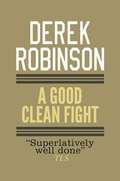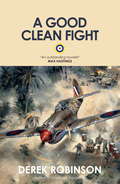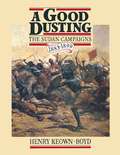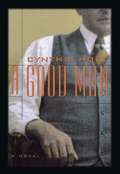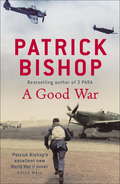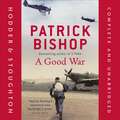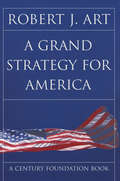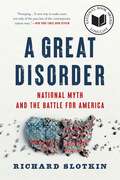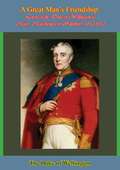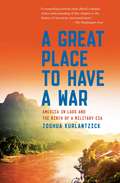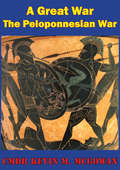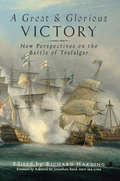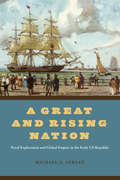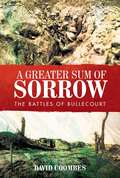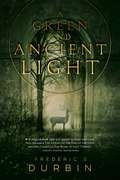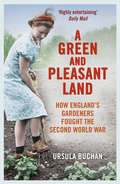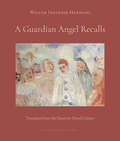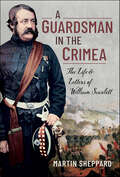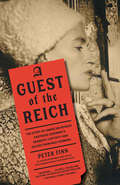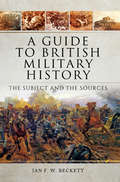- Table View
- List View
A Good African Story: How a Small Company Built a Global Coffee Brand
by Andrew RugasiraSince it was founded in 2003, Good African Coffee has helped thousands of farmers earn a decent living, send their children to school and escape a spiral of debt and dependence. Africa has received over $1 trillion in aid over the last fifty years and yet despite these huge inflows, the continent remains mired in poverty, disease and systemic corruption. In A Good African Story, as Andrew Rugasira recounts the very personal story of his company and the challenges that he has faced – and overcome – as an African entrepreneur, he provides a tantalising glimpse of what Africa could be, and argues that trade has achieved what years of aid have failed to deliver.This is a book about Africa taking its destiny in its own hands, and dictating the terms of its future.
A Good Clean Fight
by Derek RobinsonNorth Africa, 1942. Dust, heat, thirst, flies. A good clean fight, for those who like that sort of thing, and some do. From an advanced landing field, striking hard and escaping fast, our old friends from Hornet Squadron (Piece of Cake) play Russian roulette, flying their clapped-out Tomahawks on ground-strafing forays. Meanwhile, on the ground, the men of Captain Lampard's S.A.S. patrol drive hundreds of miles behind enemy lines to plant bombs on German aircraft. This is the story of a war of no glamor and few heroes, in a setting often more lethal than the enemy.
A Good Clean Fight
by Derek RobinsonNorth Africa, 1942. Dust, heat, thirst, flies. A good clean fight, for those who like that sort of thing, and some do. From an advanced landing field, striking hard and escaping fast, our old friends from Hornet Squadron (Piece of Cake) play Russian roulette, flying their clapped-out Tomahawks on ground-strafing forays. Meanwhile, on the ground, the men of Captain Lampard's S.A.S. patrol drive hundreds of miles behind enemy lines to plant bombs on German aircraft. This is the story of a war of no glamour and few heroes, in a setting often more lethal than the enemy.
A Good Clean Fight
by Derek RobinsonNorth Africa, 1942. Dust, heat, thirst, flies. A good clean fight, for those who like that sort of thing, and some do. From an advanced landing field, striking hard and escaping fast, our old friends from Hornet Squadron (Piece of Cake) play Russian roulette, flying their clapped-out Tomahawks on ground-strafing forays. Meanwhile, on the ground, the men of Captain Lampard's S.A.S. patrol drive hundreds of miles behind enemy lines to plant bombs on German aircraft. This is the story of a war of no glamour and few heroes, in a setting often more lethal than the enemy.
A Good Death
by Elizabeth IronsideAt once a suspenseful mystery and a heartfelt tale of a man's attempts to sort out the tangled remains of a life torn apart by war ... Ironside's landscapes are rich, if decimated, and her characters extraordinarily intriguing--Birmingham Post (UK).
A Good Dusting: The Sudan Campaigns, 1883–1899
by Henry Keown-BoydThis book is about the Sudan Campaigns fought during the last two decades of the nineteenth century. This book covers the complete saga from 1883 1899.
A Good Man: A Novel
by Cynthia HolzWhen his best friend is murdered in a fit of jealous rage, Izzy Schneider is compelled to reconstruct the relationship and exhume a hidden past that tests the authority of truth and weighs the burden of history. In A Good Man, critically acclaimed novelist Cynthia Holz examines Izzy’s complex lifelong friendship with Phil Lewis. Izzy escapes from Nazi Germany as a young man, leaving behind his family, who later perish in the Holocaust; Phil, a war hero, stays and fights with the partisans and saves hundreds of lives. For the rest of his life, Izzy suffers constant, unbearable guilt because he did not remain to fight like his friend Phil, and because his family is lost forever. Izzy’s daughter, Eva, tangled in the legacy of Phil’s good life and Izzy’s shame, struggles to understand her father and to make amends for a secret love affair that threatens to tear both families apart. A superb story of loss and regret, A Good Man explores history distorted through the shaded lens of time.
A Good War
by Patrick BishopAdam Tomaszewski is a Polish airman, flying Hurricanes alongside British pilots as the Battle of Britain rages in the summer skies over Kent and Sussex. Facing death daily and far from his friends and family, Adam finds himself drawn to a maverick Irish soldier called Gerry Cunningham.'You're out of luck, brother,' are the first words Gerry says when they meet in the crush of men competing for the few women at a dance in a seaside hotel, but when Gerry betrays his lover Moira, Adam's fortunes seem to have changed. For the next four years, Adam's life and Gerry's are intertwined like good luck and bad, love and loss, life and death, their paths crossing at various points on Adam's perilous journey from the ruins of Poland to the rolling English countryside, from Egypt to Occupied France.A hauntingly evocative picture of wartime Britain, a twisting drama of fighting behind enemy lines, a compelling, suspenseful love story, A GOOD WAR proves Patrick Bishop - already acclaimed as a great historian of the war in the air - to be a superbly gifted novelist.
A Good War
by Patrick BishopAdam Tomaszewski is a Polish airman, flying Hurricanes alongside British pilots as the Battle of Britain rages in the summer skies over Kent and Sussex. Facing death daily and far from his friends and family, Adam finds himself drawn to a maverick Irish soldier called Gerry Cunningham.'You're out of luck, brother,' are the first words Gerry says when they meet in the crush of men competing for the few women at a dance in a seaside hotel, but when Gerry betrays his lover Moira, Adam's fortunes seem to have changed. For the next four years, Adam's life and Gerry's are intertwined like good luck and bad, love and loss, life and death, their paths crossing at various points on Adam's perilous journey from the ruins of Poland to the rolling English countryside, from Egypt to Occupied France.A hauntingly evocative picture of wartime Britain, a twisting drama of fighting behind enemy lines, a compelling, suspenseful love story, A GOOD WAR proves Patrick Bishop - already acclaimed as a great historian of the war in the air - to be a superbly gifted novelist.(P)2011 Hodder Headline Ltd
A Grand Strategy for America (Cornell Studies in Security Affairs)
by Robert J. ArtThe United States today is the most powerful nation in the world, perhaps even stronger than Rome was during its heyday. It is likely to remain the world's preeminent power for at least several decades to come. What behavior is appropriate for such a powerful state? To answer this question, Robert J. Art concentrates on "grand strategy"-the deployment of military power in both peace and war to support foreign policy goals. He first defines America's contemporary national interests and the specific threats they face, then identifies seven grand strategies that the United States might contemplate, examining each in relation to America's interests. The seven are: -dominion-forcibly trying to remake the world in America's own image; - global collective security-attempting to keep the peace everywhere; -regional collective security-confining peacekeeping efforts to Europe; - cooperative security-seeking to reduce the occurrence of war by limiting other states' offensive capabilities; - isolationism-withdrawing from all military involvement beyond U. S. borders; -containment-holding the line against aggressor states; and -selective engagement-choosing to prevent or to become involved only in those conflicts that pose a threat to the country's long-term interests. Art makes a strong case for selective engagement as the most desirable strategy for contemporary America. It is the one that seeks to forestall dangers, not simply react to them; that is politically viable, at home and abroad; and that protects all U. S. interests, both essential and desirable. Art concludes that "selective engagement is not a strategy for all times, but it is the best grand strategy for these times. "
A Great Disorder: National Myth and the Battle for America
by Richard SlotkinAs culture wars pit us against each other, A Great Disorder looks to the myths that have shaped American identity and reveals how they have brought us to the brink of an existential crisis.Red America and Blue America are so divided they could be two different countries, with wildly diverging views of why government exists and who counts as American. Their ideologies are grounded in different versions of American history, endorsing irreconcilable visions of patriotism and national identity.A Great Disorder is a bold, urgent work that helps us make sense of today’s culture wars through a brilliant reconsideration of America’s foundational myths and their use in contemporary politics. Famous for his trilogy on the Myth of the Frontier, Richard Slotkin identifies five myths, born of different eras, that have shaped our conception of what it means to be American: the myths of the Frontier, the Founding, the Civil War (which he breaks into two opposing camps, Emancipation and the Lost Cause), and the Good War, embodied by the multiethnic platoon fighting for freedom. His argument is that while Trump and his MAGA followers have played up a frontier-inspired hostility to the federal government and rallied around Confederate symbols to champion a racially exclusive definition of American nationality, Blue America, taking its cue from the protest movements of the 1960s, envisions a limitlessly pluralistic country in which the federal government is the ultimate enforcer of rights and opportunities. American history—and the foundations of our democracy—have become a battleground. It is not clear at this time which vision will prevail.
A Great Man’s Friendship: Letters of the Duke of Wellington to Mary, Marchioness of Salisbury, 1850-1852
by Lady Burghclere The Duke of WellingtonOriginally published in 1927 and edited by Lady Winifred Anne Henrietta Christiana (Herbert) Burghclere, this book is a collection of the Duke of Wellington's letters to one of his regular correspondents and friend, Mary Catherine Gascoyne-Cecil, Marchioness of Salisbury. The letters in this volume cover the years 1850-1852--the last two years of the Duke of Wellington's life. It ends with the Duke's final note dated September 13, 1952, the eve of his death."The Duke's actions were sometimes mistaken, his judgments sometimes faulty, but the advocatus diaboli can find nothing to challenge in the limpid sincerity of his selfless motives. In these letters, too, the man's kindliness, the "good nature" he proclaimed as so important an ingredient, even in public affairs, is markedly apparent."It is also an illustration of the force of willpower to see an octogenarian able to put through the business which every day brought him. He might grumble that "every animal but the Duke of Wellington is allowed a rest," but the myriad tasks, the countless courtesies and kindnesses, were achieved largely by his lifelong system "to do the business of the day in the day."It is therefore to be hoped that the perusal of these letters will give their readers a more intimate acquaintance with one whose whole career and character must be a source of pride to those of his own race."Illustrated with Portraits.
A Great Place to Have a War: America in Laos and the Birth of a Military CIA
by Joshua KurlantzickThe untold story of how America&’s secret war in Laos in the 1960s transformed the CIA from a loose collection of spies into a military operation and a key player in American foreign policy.January, 1961: Laos, a tiny nation few Americans have heard of, is at risk of falling to communism and triggering a domino effect throughout Southeast Asia. This is what President Eisenhower believed when he approved the CIA&’s Operation Momentum, creating an army of ethnic Hmong to fight communist forces there. Largely hidden from the American public—and most of Congress—Momentum became the largest CIA paramilitary operation in the history of the United States. The brutal war lasted more than a decade, left the ground littered with thousands of unexploded bombs, and changed the nature of the CIA forever. With &“revelatory reporting&” and &“lucid prose&” (The Economist), Kurlantzick provides the definitive account of the Laos war, focusing on the four key people who led the operation: the CIA operative whose idea it was, the Hmong general who led the proxy army in the field, the paramilitary specialist who trained the Hmong forces, and the State Department careerist who took control over the war as it grew. Using recently declassified records and extensive interviews, Kurlantzick shows for the first time how the CIA&’s clandestine adventures in one small, Southeast Asian country became the template for how the United States has conducted war ever since—all the way to today&’s war on terrorism.
A Great War - More Worthy Of Relation Than Any That Had Preceded It: The Peloponnesian War As A Rosetta Stone For Joint Warfare And Operational Art
by Cmdr Kevin M. McGowanThe study of military history is a vital component of Joint Professional Military Education (JPME) as a complement to the study of Joint Doctrine. The Joint Military Operations Historical Collection (JMOHC) illustrates principles of Joint Doctrine and Joint Force Employment through historical and modern example of U.S. Joint Force Operations.Thucydides' history of the Peloponnesian War is recognized dogmatically as a definitive text with regard to the study of National Strategy and Policy, international relations, and political science. In addition to being the first true military historian, many regard Thucydides as the father of the study of International Relations, and the first writer in the intellectual tradition of Realism. This paper proposes that Thucydides history of the 27 year long Peloponnesian War is not only important to Strategic level of military studies, but is equally applicable to the military studies at the Operational level of war. Thucydides history is the first account of complex Joint Military Operations (JMO) in a major conflict between the joint forces (land and sea) of multi-national coalitions fighting in multiple theaters (sometimes simultaneously) across multiple domains. This paper will demonstrate that the fundamentals of Joint Force Employment were clearly validated in the Peloponnesian War as the outcome at key decisive points (Major Operations) was ultimately determined by superior (or inferior) operational execution when examined within the frameworks of the Principles of War and Center of Gravity at the Operational level.Finally, this paper will draw conclusions as to which principles of Joint Force Employment were the most determinant in the Peloponnesian War and draw lessons learned based upon these conclusions as to the enduring importance of the Principles of War and Operational Art for Joint Force Planning and Joint Force Employment in the modern era.
A Great and Glorious Victory: New Perspectives on the Battle of Trafalgar
by Richard HardingIn October 2005 an international naval conference was held at Portsmouth and well-known historians and naval officers from around the world, including Colin White, Brian Lavery, Contre Amiral Remi Monaque and Admiral Sir Jonathan Band, now First Sea Lord, gave a series of papers on aspects of the battle of Trafalgar. Containing a wealth of new information they are now form the core of this book. Twelve chapters cover every aspect of the battle but also explore important associated themes such as the Grand Armee and the invasion threat, and the British defenses against invasion in the years before 1805. On the battle itself there are pieces on the ships, men and the tactics, and important chapters from the French and Spanish perspectives. Perhaps the most groundbreaking contribution is from the Inshore Squadron, a naval war-gaming group, which produced a timeline that is the most accurate yet available and reveals, amongst other things, the nature of the ship-on-ship actions and the timing of some of the set events. Put into its strategic, political and economic context, the battle is brought to life in a way which distinguishes it from all the other accounts that have appeared and offers enthusiasts and historians the most up-to-date and important reassessment that is available.
A Great and Rising Nation: Naval Exploration and Global Empire in the Early US Republic (American Beginnings, 1500-1900 Ser.)
by Michael A. VerneyA Great and Rising Nation illuminates the unexplored early decades of the United States’ imperialist naval aspirations. Conventional wisdom holds that, until the Spanish-American War of 1898, the United States was a feeble player on the world stage, with an international presence rooted in commerce rather than military might. Michael A. Verney’s A Great and Rising Nation flips this notion on its head, arguing that early US naval expeditions, often characterized as merely scientific, were in fact deeply imperialist. Circling the globe from the Mediterranean to South America and the Arctic, these voyages reflected the diverse imperial aspirations of the new republic, including commercial dominance in the Pacific World, religious empire in the Holy Land, proslavery expansion in South America, and diplomatic prestige in Europe. As Verney makes clear, the United States had global imperial aspirations far earlier than is commonly thought.
A Greater Sum of Sorrow: The Battles of Bullecourt
by David CoombesIn April-May 1917 the sleepy hamlet of Bullecourt in northern France became the focus of two battles involving Australian and British troops. Given the unique place in this nation’s military history that both battles occupy, surprisingly little has been written on the AIF’s achievements at Bullecourt. A Greater Sum of Sorrow seeks to remedy this gaping omission. The First Battle of Bullecourt marked the Australians’ introduction to the latest battlefield weapon — the tank. This much-lauded weapon failed dismally amid enormous casualties. Despite this, two infantry brigades from the 4th Australian Division captured parts of the formidable Hindenburg Line with minimal artillery and tank support, repulsing German counter-attacks until forced to withdraw. In the second battle, launched with a preliminary artillery barrage, more Australian divisions were forced into the Bullecourt ‘meat-grinder’ and casualties soared to over 7000. Again Australian soldiers fought hard to capture parts of the enemy line and hold them against savage counter-attacks. Bullecourt became a charnel-house for the AIF. Many who had endured the nightmare of Pozières considered Bullecourt far worse. And for what? While Field Marshal Sir Douglas Haig considered its capture ‘among the great achievements of the war’, the village that cost so many lives held no strategic value whatsoever.
A Green and Ancient Light
by Frederic S. DurbinA gorgeous fantasy in the spirit of Pan's Labyrinth and John Connolly's The Book of Lost Things.Set in a world similar to our own, during a war that parallels World War II, A Green and Ancient Light is the stunning story of a boy who is sent to stay with his grandmother for the summer in a serene fishing village. Their tranquility is shattered by the crash of a bullet-riddled enemy plane, the arrival of grandmother's friend Mr. Girandole--a man who knows the true story of Cinderella's slipper--and the discovery of a riddle in the sacred grove of ruins behind grandmother's house. In a sumptuous idyllic setting and overshadowed by the threat of war, four unlikely allies learn the values of courage and sacrifice.
A Green and Pleasant Land: How England’s Gardeners Fought the Second World War
by Ursula BuchanSHORTLISTED FOR INSPIRATIONAL BOOK OF THE YEAR AT THE 2014 GARDEN MEDIA GUILD AWARDS. The wonderfully evocative story of how Britain’s World War Two gardeners – with great ingenuity, invincible good humour and extraordinary fortitude – dug for victory on home turf.A Green and Pleasant Land tells the intriguing and inspiring story of how Britain's wartime government encouraged and cajoled its citizens to grow their own fruit and vegetables. As the Second World War began in earnest and a whole nation listened to wireless broadcasts, dug holes for Anderson shelters, counted their coupons and made do and mended, so too were they instructed to ‘Dig for Victory’. Ordinary people, as well as gardening experts, rose to the challenge: gardens, scrubland, allotments and even public parks were soon helping to feed a nation deprived of fresh produce. As Ursula Buchan reveals, this practical contribution to the Home Front was tackled with thrifty ingenuity, grumbling humour and extraordinary fortitude. The simple act of turning over soil and tending new plants became important psychologically for a population under constant threat of bombing and even invasion. Gardening reminded people that their country and its more innocent and insular pursuits were worth fighting for. Gardening in wartime Britain was a part of the fight for freedom.
A Guardian Angel Recalls
by Willem Frederik HermansWillem Frederik Hermans's lucid and exhilarating WWII masterpiece in a razor-sharp translation by David ColmerA Guardian Angel Recalls is a gripping and diabolical wartime novel by one of the most provocative Dutch writers of the twentieth-century. Alberegt, a frenzied and lovelorn public prosecutor, speeds through Hook of Holland in his black Renault on May 9, 1940 – the eve of the German invasion of the Netherlands. Guiding his every move is a guardian angel. With unflappable patience, the angel flits from the hood of the Renault to the rim of his windswept hat, determined to quell his every anxiety and doubt. The angel's momentary distraction, however, sets off a chain of events that spins a nightmarish web. Alberegt's elusive companion serves both as narrator and meddlesome driver of the plot, though not without the interventions of a rotating cast of devils.
A Guardsman in the Crimea: The Life & Letters of William Scarlett
by Martin SheppardThe Brigade of Guards was the elite force of the British Army in the Crimea. William Scarlett, a captain in the Scots Fusilier Guard and one of the most active junior officers in the regiment, fought throughout the entire campaign. After the Allied landing at Kalamita Bay, Scarlett rallied his regiment at a critical moment during the battle of the Alma, supported by his company sergeant, who was awarded the VC. William Scarlett’s life may well have been saved after the battle of Balaklava by becoming an aide de camp to his uncle, General James Scarlett, the commander of the Heavy Brigade. This meant that he did not fight at Inkerman, which took a heavy toll on the officers of the Guards Brigade. Returning to the trenches early in 1855, William Scarlett was involved in all the phases of the siege of Sebastopol until its fall in September 1855. The survival of 139 previously unpublished letters record Scarlett’s deeds and thoughts. Written to nineteen different correspondents, and deliberately intended by him to form a personal account of his rôle in the war, his letters provide a forceful commentary on the successes and failures of the British army in the East. His life before and after the war is well recorded. Becoming the third Lord Abinger in 1861, Scarlett was the second English peer to marry an American. He built a castle in Scotland, where Queen Victoria stayed in 1873, and two of his daughters became notable suffragettes.
A Guerra Inesquecível do Vietnã: A Guerra Americana no Vietnã – A Guerra da Selva
by Lygia Decker Scott S. F. MeakerDescrição do livro Nota: ***** Este é um pequeno livro sobre a Guerra do Vietnã ***** A Guerra do Vietnã foi uma luta como uma guerra e terminou com os dois lados acreditando que haviam vencido. Mas essa foi uma guerra que iniciou sem uma declaração formal de guerra. Na história do Vietnã, o número de combates pelo poder é algo impressionante. As batalhas eram curtas e intensas e aconteciam na selva e em arrozais. Grande parte da guerra envolveu ataques guerrilheiros.
A Guest of the Reich: The Story of American Heiress Gertrude Legendre's Dramatic Captivity and Escape from Nazi Germany
by Peter Finn“I read A Guest of the Reich breathlessly, and found myself amazed by the pluck, guts, and courage of Gertrude Legendre.” —Lisa Birnbach, author of True Prep “Thrilling!” —Bill Dedman, author of Empty Mansions The dramatic story of a South Carolina heiress who joined the OSS and became the first American woman in uniform taken prisoner on the Western front—until her escape from Nazi Germany. Gertrude “Gertie” Legendre was a big-game hunter from a wealthy industrial family who lived a charmed life in Jazz Age America. Her adventurous spirit made her the inspiration for the Broadway play Holiday, which became a film starring Katharine Hepburn. When the Japanese attacked Pearl Harbor, Legendre, by then married and a mother of two, joined the OSS, the wartime spy organization that preceded the CIA. First in Washington and then in London, some of the most closely-held United States government secrets passed through her hands. In A Guest of the Reich, Peter Finn tells the gripping story of how in 1944, while on leave in liberated Paris, Legendre was captured by the Germans after accidentally crossing the front lines. Subjected to repeated interrogations, including by the Gestapo, Legendre entered a daring game of lies with her captors. The Nazis treated her as a “special prisoner” of the SS and moved her from city to city throughout Germany, where she witnessed the collapse of Hitler’s Reich as no other American did. After six months in captivity, Legendre escaped into Switzerland. A Guest of the Reich is a propulsive account of a little-known chapter in the history of World War II, as well as a fascinating portrait of an extraordinary woman.
A Guide To Worship Ministry: The Worship Minister's Life And Work
by Gregory B. BrewtonA Guide to Worship Ministry centers on four main areas of worship ministry: preparing for worship ministry, leading the worship ministry, preparing for Sunday, and discipling the generations through worship ministry. The book addresses topics such as discerning your call to ministry, working on a church staff, planning and leading worship services, and equipping your worship teams. A Guide to Worship Ministry looks at the day-to-day work of the worship minister, offering insights and personal stories. It is an important book for those getting started in worship ministry and a refresher for those who have years of experience in ministry.
A Guide to British Military History: The Subject and the Sources
by Ian F. BeckettWhat exactly is military history? Forty years ago it meant battles, campaigns, great commanders, drums and trumpets. It was largely the preserve of military professionals and was used to support national history and nationalism. Now, though, the study of war has been transformed by the war and society approach, by the examination of identity, memory and gender, and a less Euro-centric and more global perspective. Generally it is recognised that war and conflict must be integrated into the wider narrative of historical development, and this is why Ian Becketts research guide is such a useful tool for anyone working in this growing field. It introduces students to all the key debates, issues and resources. While European and global perspectives are not neglected, there is an emphasis on the British experience of war since 1500. This survey of British military history will be essential reading and reference for anyone who has a professional or amateur interest in the subject, and it will be a valuable introduction for newcomers to it.

